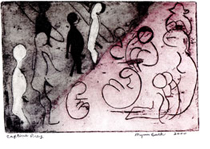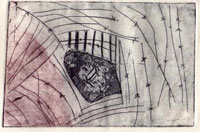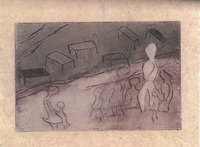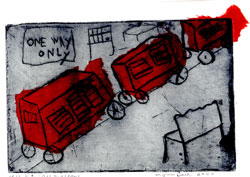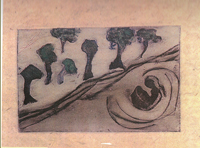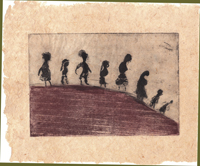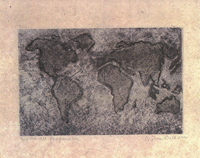 |
 |
|
One is Too Many: |
|||
|
|
|||
|
In 1998, Myrna Balk was invited by SAATHI, a non-governmental organization in Nepal, to consult on domestic violence. While there, she also taught at St. Xavier's College, School of Social Work, and visited women's shelters. In Kathmandu, she spent a great deal of time with Nepali women and girls who had been forced, for a variety of reasons, into sexual slavery. When she left Nepal in April, Myrna at first did not realize the extent to which her life had changed. She went to her studio and created a series of eight etchings that expressed her outrage toward sex trafficking. After printing the eight etchings, as shown above, Myrna was compelled to hear the stories first hand. In her second and third trips to Nepal in 2000 and 2001, Myrna visited several shelters for former sex slaves. Most of these girls and women have been victims of abuse and neglect and/or rescued from sex traffickers. The shelters provide a variety of services. One, for example, caters to HIV-positive trafficking victims; another offers a six-month leadership-training program for the women. Myrna was also invited by a college student to a village in the area of Gorkha. The student wanted Myrna to help tell the story of the Dalit, or low-caste, women. Social workers often rely on interviews to gain knowledge about culture, people, and situations. Myrna felt interviews alone would not suffice. She also wanted to draw with the women, many of whom were illiterate and unaccustomed to putting their thoughts into words—especially when speaking to strangers. "Art can have a curative, self-expressive purpose, particularly when there are no words to express the feelings. Art can also create a 'safe' mode of expression, as the work is not necessarily identified as autobiographical, thereby permitting anonymity and distance." Confirming Myrna's hypothesis, the art sessions had a transformative effect. Most of the women had never drawn before and were initially self-conscious. They chose to begin with plain paper and pencils, which felt familiar to them. But after a few minutes, the women felt freer to use the rice paper and oil pastels. They seemed to feel honored and nurtured by the process. Myrna hoped that the participants would tell her about the finished work, and they did so through an interpreter after each session. The participants reported finding a voice through the drawing experience, and they wanted Myrna to share their drawings with others. |
|||
©2008
contact Myrna Balk for permission to reprint
June 9, 2008
Contact Myrna Balk
site designed by joan schwartz

